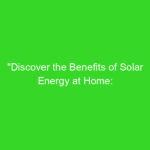
Active and Passive Solar Energy
Solar energy is the most abundant renewable energy source on the planet, and it is available for us to harness every day. The sun's energy can be captured through active and passive solar systems to provide clean, sustainable power for our homes and businesses. In this article, we will explore the differences between active and passive solar energy systems and how they work.
What is Active Solar Energy?
Active solar energy refers to the use of mechanical and electrical devices to collect, store, and distribute solar energy. Active solar systems require solar collectors, which are typically solar panels that convert sunlight into electricity. The electricity generated by the solar panels can be used to power appliances and lights in a home or building.
Active solar systems also require storage solutions, such as batteries or thermal storage tanks, to store excess energy generated by the solar panels. This stored energy can be used when the sun is not shining or when the demand for electricity is higher than the solar panel's output.
Active solar systems can be integrated into a building's design, or they can be added as retrofits to an existing structure. They are commonly used in residential and commercial applications, and they can provide significant energy savings over traditional energy sources.
What is Passive Solar Energy?
Passive solar energy refers to the use of building design principles to capture and use solar energy without the use of mechanical or electrical devices. Passive solar systems rely on a building's orientation, materials, and design features to collect, store, and distribute solar energy.
Passive solar design principles include the use of thermal mass, which is a material that stores heat and releases it slowly, and orientation, which refers to the alignment of a building with the sun's path. Other design features, such as shading devices and insulation, can also be used to optimize the building's use of solar energy.
Passive solar systems are commonly used in residential construction, but they can also be used in commercial buildings. They are an effective way to reduce energy consumption and greenhouse gas emissions while providing a comfortable living or working environment.
Active vs. Passive Solar Energy Systems
The main difference between active and passive solar energy systems is the use of mechanical and electrical devices. Active solar systems require solar panels and other equipment to collect, store, and distribute solar energy, while passive solar systems rely on a building's design features.
Active solar systems are typically more expensive to install than passive solar systems, but they can provide more energy output and can be used in a wider range of applications. Passive solar systems are less expensive to install, but they require careful design and construction to ensure maximum efficiency.
Active solar systems are also more complex and require more maintenance than passive solar systems. Solar panels need to be cleaned and inspected regularly, and the batteries or thermal storage tanks need to be maintained and replaced periodically. Passive solar systems require less maintenance but may require occasional repairs or adjustments to optimize performance.
Benefits of Active and Passive Solar Energy
Both active and passive solar energy systems offer significant benefits over traditional energy sources. Solar energy is clean, sustainable, and abundant, and it can help reduce greenhouse gas emissions and dependence on fossil fuels.
Active solar systems can provide significant energy savings and can be used in a wide range of applications, from residential to commercial, and even industrial. They can also be used in remote locations where there is no access to traditional energy sources.
Passive solar systems can also provide energy savings and can be used in a wide range of residential and commercial applications. They can help reduce heating and cooling costs, improve indoor air quality, and provide a comfortable living or working environment.
Conclusion
Active and passive solar energy systems both offer significant benefits over traditional energy sources. Active solar systems require more equipment and maintenance but can provide more energy output and can be used in a wider range of applications. Passive solar systems require careful design and construction but are less expensive to install and require less maintenance.
Whichever system you choose, solar energy is an excellent choice for reducing energy costs, improving indoor air quality, and helping to protect the environment. With the help of a qualified solar energy professional, you can design and install a solar energy system that meets your needs and provides long-term energy savings.





